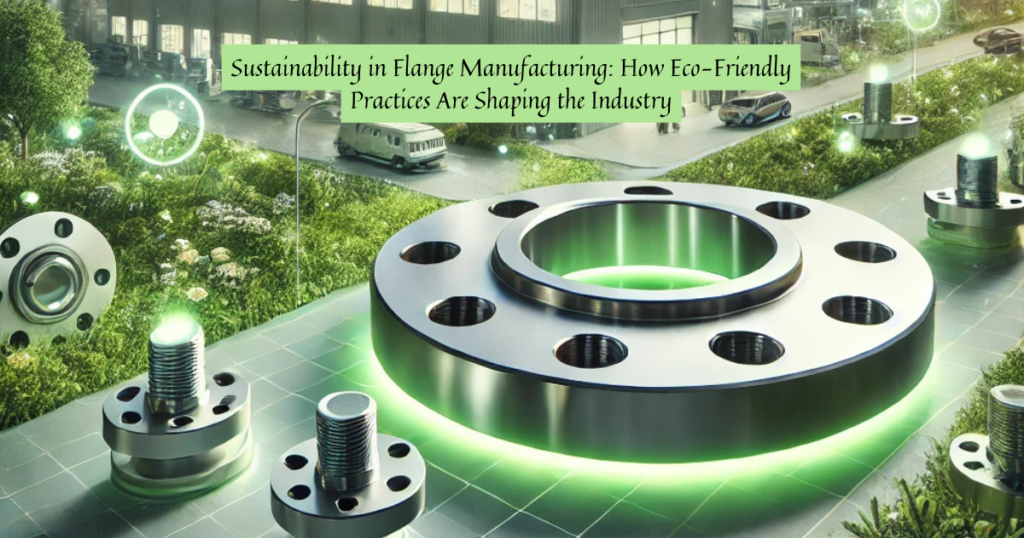Sustainability in Flange Manufacturing: How Eco-Friendly Practices Are Shaping the Industry
In today’s industrial landscape, sustainability is more than just a buzzword—it’s necessary. Industries worldwide, including flange manufacturing, are under increasing pressure to adopt eco-friendly practices to meet environmental regulations, reduce carbon footprints, and appeal to eco-conscious customers. This blog delves into how sustainability transforms flange manufacturing, from material sourcing to production processes, and explores the benefits for businesses and the planet.

Introduction to Sustainability in Manufacturing
Sustainability in manufacturing focuses on minimizing environmental impact while maintaining efficiency and profitability. For flange manufacturers, this means adopting practices that reduce energy consumption, utilize recyclable materials, and manage waste responsibly. With industries like oil and gas, petrochemicals, and waterworks demanding high-quality, eco-friendly components, sustainable flange manufacturing is rapidly becoming a critical factor in the supply chain.
Sustainable Materials in Flange Production
The Rise of Recycled Steel
Recycled steel is gaining traction as a sustainable material for flange production. By repurposing steel scraps, manufacturers significantly reduce the need for mining and processing raw materials, which are energy-intensive and harmful to the environment.
Advantages of Using Sustainable Materials:
- Cost-Effective: Recycled materials lower production costs while maintaining durability and performance.
- Environmentally Friendly: Reduces carbon emissions and conserves natural resources.
- Performance-Driven: Recycled steel maintains the strength and corrosion resistance required for industrial applications.
Energy-Efficient Manufacturing Processes
Manufacturing processes play a crucial role in sustainability. Many flange manufacturers are now investing in advanced technologies that lower energy consumption while maintaining high production standards.
Key Energy-Efficient Practices:
- Automation and Smart Machinery: Reduces energy wastage by optimizing manufacturing cycles.
- Renewable Energy Integration: Using solar or wind energy to power production facilities.
- Efficient Heat Treatment: Minimizing energy use during processes like forging and annealing.
By adopting these technologies, manufacturers not only reduce their environmental footprint but also cut operational costs, enhancing their competitive edge.
Waste Management in Flange Manufacturing
Waste management is another cornerstone of sustainability. During flange production, significant waste is generated in the form of steel scraps, cutting fluids, and industrial by-products.
Effective Waste Management Strategies:
- Repurposing Scraps: Steel scraps can be melted and reused, minimizing waste.
- Recycling Coolants: Cutting fluids used during machining are treated and recycled.
- Reducing Packaging Waste: Eco-friendly packaging materials reduce non-biodegradable waste.
These strategies help manufacturers comply with environmental regulations and enhance their reputation as eco-conscious businesses.
Impact on Industrial Applications
Eco-friendly flanges are critical in industries where sustainability is a priority, such as:
- Oil and Gas: High-performance flanges with sustainable coatings improve efficiency while reducing the environmental impact of operations.
- Waterworks: Eco-friendly flanges ensure safe and sustainable water distribution systems.
- Petrochemicals: Corrosion-resistant, sustainable flanges reduce maintenance costs and environmental hazards.
- Power Generation: Sustainable flanges withstand high-pressure environments, ensuring reliable and clean energy production.
Future Trends in Sustainable Flange Manufacturing
The future of flange manufacturing lies in innovation and adaptation to global sustainability goals. Here are some trends shaping the industry:
- Green Coating Technologies: Advanced coatings like epoxy or zinc enhance corrosion resistance while being environmentally safe.
- 3D Printing: Reduces material waste and energy consumption by creating flanges with precision.
- ISO 14001 Certification: Flange manufacturers are adopting this standard to showcase their commitment to environmental management systems.
Benefits of Sustainability for Flange Manufacturers
- Market Advantage: Eco-conscious buyers prefer suppliers with sustainable practices.
- Regulatory Compliance: Reduces the risk of penalties associated with environmental violations.
- Long-Term Savings: Energy-efficient and waste-reducing practices lower operational costs.
Conclusion
Sustainability in flange manufacturing is no longer optional—it’s essential. Flange manufacturers can reduce their environmental impact, improve operational efficiency, and gain a competitive advantage in the market by adopting eco-friendly materials, energy-efficient processes, and effective waste management strategies. As the demand for sustainable solutions grows, investing in green practices today will ensure a better tomorrow for the industry and the planet.
